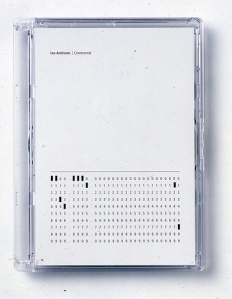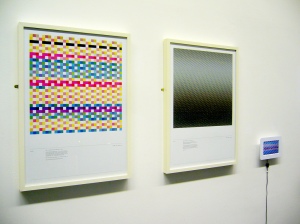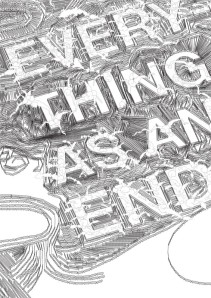Within the previous posts, regarding current influences for my work, all the examples share a common ground, the final image had been developed exclusively through an illustration software. This made me begin to consider the (over)use of digital software within graphic design.
The world of Graphic Design changed irreversibly following the integration of computer graphics. The first Graphical User Interface (GUI) utilising images to express the input and output of a computer program became available to the consumer in 1981.1 Following this the launch of the first commercially available full Macintosh system in 1984 reshaped the formation, distribution and perception of graphic design.2
Anon, n.d. The First Apple Macintosh System – 1984. [electronic print] Available at: <http://www.mac-history.de/wp-content/uploads/2008/05/544px-macintosh.jpg> [Accessed 16th December 2011].
This led to the introduction of digital design, exponentially expanding until today, where it is now considered a necessity. However it has become a topic of debate as to the effects of this computer-based design trend to our creativity, our ability as designers and finally our individuality.
In an article for Eye Magazine, Adrian Shaughnessy claims;
Graphic design appears to have settled into a complacent middle age, content to be in the thrall of corporatism, branding, marketing, focus groups and quick-fix makeover culture.3
And I agree. Everywhere visual identities are released, honed to perfection within Adobe Illustrator, and although differing in their product, virtually identical in their design.
Within an article I recently read for ‘graphic design trends’ focussing on the commercial and corporate, the lack of individuality and ingenuity was astounding.
https://www.elance.com/p/blog/2011/02/graphic-design-trends-for-2011.html
Here the author provides the designer with ‘solutions’ to follow the trend in graphic design and succinctly provide adequate ‘solutions’ to clients.
Logos are focusing more on simple glyphs, simple shapes, understated text and simple colors.
 Anon, 2011. Enogy Logo. [electronic print] Available at: <https://www.elance.com/p/files/image/1_enoguy_logo.jpg> [Accessed 16th December 2011].
Anon, 2011. Enogy Logo. [electronic print] Available at: <https://www.elance.com/p/files/image/1_enoguy_logo.jpg> [Accessed 16th December 2011].
Is this what the world of graphic design has become? Providing clients with satisfactory carbon-copy designs? Are we no longer capable of daring to present something alternative?
In a further article relaying the “45 Creative and Beautiful Logo Design You Should’ve Seen” while many are witty and interesting, the same illustrator effects are shamelessly applied.
http://dzineblog.com/2010/02/45-creative-and-beautiful-logo-design-you-shouldve-seen.htm
Chrobot, P., 2009. On Wine. [electronic print] Available at: <http://logofaves.com/wp-content/uploads/2009/09/onwine_m.jpg> [Accessed 16th December 2011].
Waze, 2009. Waze Logo. [electronic print] Available at: <http://logofaves.com/wp-content/uploads/2009/08/waze_m.jpg> [Accessed 16th December 2011].
We are exposed continually to identical ‘ideas’. The unveiling of the new UPS logo in 2003 sparked controversy. Working alongside FutureBrand, the new UPS logo was developed following two years of strategic research and planning (!)4 In a small archived article from Under Consideration, a discussion arises as to the removal of Paul Rand’s original, monumental design and analysis of the comment “For even greater visual impact, the shield gained a three-dimensional appearance”5. I agree with the analysis that if added ‘visual impact’ is required in the form of 3D shading, the logo was inevitably weak to begin with.
FutureBrand, 2003. UPS Logo. [online] Available at: <http://inspiredology.com/wp-content/uploads/2011/11/ups.jpg> [Accessed 16th December 2011].
Expanding further, thanks to the commercially available software we are plagued by bad design.
The below example for Kabbee is commonly promoted throughout the London Transport Network.

Kabbee Logo, Lawtz Design
Lawtz Design, 2011. Kabbee Logo. [electronic print] Available at: <http://ducktoid.com/wp-content/uploads/Kabbee-top1.bmp> [Accessed 16th December 2011]
Within his published timeline in Eye Magazine, 2011, David Barringer highlights that although tools have changed drastically over the last 20 years, this does not affect our ability as designers.6
My own experience converting my analogue designs to digital has been a struggle. I initially found vector-based software such as Adobe Illustrator difficult to control. I found I was unable to direct my design in the way I was intending as it was not intuitive to me. However after what has felt like a continuous battle, I believe I am beginning to break through to controlling the programme, instead of it controlling me.
Many designers are beginning to explore the possibility of exploiting the computer beyond the initial envisaged realms of the commercial software. Within an article for Eye Magazine in 2003, Adrian Shaughnessy introduces new avenues of exploration for designers. One of particular interest in this narrow world of Illustrator-based design is what he describes as “Laptop Aesthetics”.7
Cited as a misuse of technology, designers are punishing the narrow software, exploiting the irregularities that occur and rejoicing in the non-highly polished outcome. Angela Lorenz, the graphic artist based in Berlin and Vienna has been involved in many projects across the last decade, both solo and notable close collaborations with Chris Murphy.8
Lorenz, A. and Murphy, C., 2002. Ian Andrews – Ceremonial. [electronic print] Available at: <http://farm3.static.flickr.com/2803/5863407650_fe920640f1.jpg> [Accessed 16th December 2011].
I enjoy Lorenz’s postmodernist attack on the digital design trend. Stripping away the superfluous effects and maintaining an engaging response is something I was looking to achieve in my final piece.
In the below Template Exhibition at SightSonic, Lorenz displayed one of my favourite pieces of her work, “Tweed”, right.
G, J., 2008. Template, SightSonic. [electronic print] Available at: <http://www.flickr.com/photos/joeg/2342895574/> [Accessed 16th December 2011].
Looking further into the topic of the future for digital design I begun to read Iman Moradi and Ant Scott’s Glitch: Designing Imperfection, which I will review in a later post.
Qubik Design, 2009. Glitch: Designing Imperfection. [electronic print] Available at: <http://www.qubik.com/images/p5.jpg> [Accessed 16th December 2011].
Expanding further into this, Jürg Lehni and Jonathan Puckey have been developing an integration between Adobe Illustrator and Lehni’s open source software plug-in, Scriptographer.9 In the two articles in Eye Magazine relating to the use of Scriptographer it is interesting to see how both authors believe Scriptographer will further break open the world of Illustrator and Digital Design. A decade since its original release in 2001, I investigated what work of interest had been created using this amalgamation.
Anon, 2007. The Classroom – Jan Van Toorn. [electronic print] Available at: <http://blog.youworkforthem.com/wp-content/uploads/2007/12/cl_janvantoorn1.jpg> [Accessed 16th December 2011].
I find this piece interesting, the complex patterns forming the letters at different magnifications would have been incredibly time-consuming to create by hand. I will now download and look into the use of Scriptographer within my own Illustrator pieces.
A further example from the Scriptographer gallery is below.
Coquoz, G., Moret, D. and Grin, M., 2009. Barriers. [electronic print] Available at: <http://scriptographer.org/gallery/scriptographer-workshop-4/posts/2969/resources/Barriers.jpg?v=cc6d7cd2b146f6beafc3a5cb731ffe56> [Accessed 16th December 2011].
Finally, as previously discussed in The Importance of Sketching (link) the recent arcticle for Smashing Magazine, calls for a combination of analogue and digital techniques, again removing the perfectly-honed design.10
Mottram, D., 2011. Image for Article. [electronic print] Available at: <http://media.smashingmagazine.com/wp-content/uploads/2011/11/ImageForArticle.jpg> [Accessed 16th December 2011].
In conclusion; I believe we need to harness the digital tools available, as many designers are attempting, however be determined to not allow them to steer the direction of our work due to either their limitations or ours.
—
References
1. Anon, 2009. The Computer Era. [online] Available at: <http://designhistory.org/Digital_Revolution.html> [Accessed 16th December 2011].
2. Anon, 2011. The History of the Apple Macintosh. [online] Available at: <http://www.mac-history.net/the-history-of-the-apple-macintosh> [Accessed 16th December 2011].
3. Shaughnessy, A., 2003. Laptop Aesthetics. Eye Magazine [online] Available at: <http://www.eyemagazine.com/feature.php?id=71&fid=471> [Accessed 16th December 2011].
4. UPS Public Relations, n.d. The UPS Logo – A Brief History. [online] Available at: <http://www.pressroom.ups.com/Fact+Sheets/The+UPS+Logo+-+A+Brief+History> [Accessed 16th December 2011].
5. Armin, 2003. UPS Says Bye-Bye to Rand.[online] Available at: <http://www.underconsideration.com/speakup/archives/001403.html> [Accessed 16th December 2011].
6. Barringer, D., 2011. Tools of the Trade. Eye Magazine [online] Available at: <http://www.eyemagazine.com/feature.php?id=194&fid=892> [Accessed 16th December 2011].
7. Shaughnessy, A., 2003. Laptop Aesthetics. Eye Magazine [online] Available at: <http://www.eyemagazine.com/feature.php?id=71&fid=471> [Accessed 16th December 2011].
8. Anon, 2011. Historical Digital. Eye Magazine Blog [online] Available at: <http://blog.eyemagazine.com/?p=5953> [Accessed 16th December 2011].
9. Lehni, J., 2011. Teaching in the spaces between code and design. Eye Magazine [online] Available at: <http://www.eyemagazine.com/feature.php?id=195&fid=898> [Accessed 16th December 2011].
10. Mottram, D., 2011. Mixing Up Illustration: Combining Analogue and Digital Techniques. Smashing Magazine. [online] Available at: <http://www.smashingmagazine.com/2011/12/07/mixing-up-illustration-combining-analog-and-digital-techniques/> [Accessed 7th December 2011].









